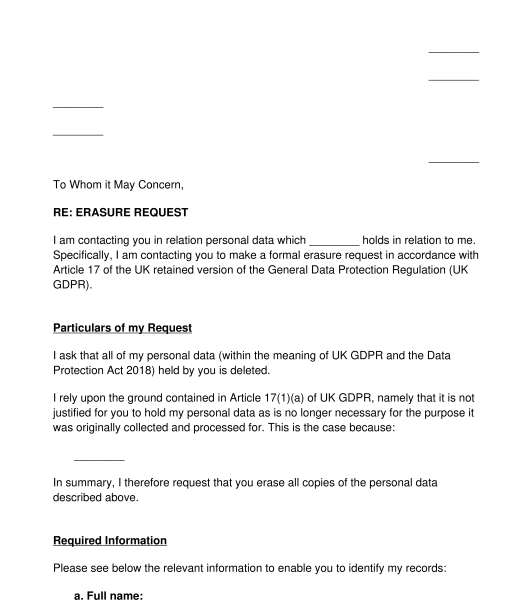 30/09/2025
30/09/2025

Answer a few questions and your document is created automatically.

Your document is ready! You will receive it in Word and PDF formats. You will be able to modify it.

 30/09/2025
30/09/2025
 Word and PDF
Word and PDF
 1 page
1 page
A letter requesting the deletion of personal data can be sent to an organisation by an individual to request the erasure of their personal data. The formal term used to describe this type of request is an erasure request. The letter can be sent by an individual who is living in the United Kingdom.
A subject access request (SAR) can be used by an individual to request copies of their personal data, and other important information about how their personal data is being used.
An erasure request can be used by an individual to request the permanent deletion of their personal data.
A rectification request can be used where the owner of the personal data is content for their records to be kept by the relevant organisation but would like particular errors to be corrected on those records.
An erasure request can be used to request the permanent deletion of their personal data.
No, it is possible to make the request verbally. However, a request in writing can be helpful so that there is a written record of:
Personal data means any information relating to an identified or identifiable natural person (a data subject). It is therefore information from which a person may be identified directly or indirectly. Examples of personal data include a data subject's:
The data subject (the owner of the personal data) can make an erasure request, It is also possible for a third party to make a request on behalf of an individual. A third party must have the necessary authority to make the request. Usually, their authority will be evidenced via a written consent form or a valid power of attorney.
Once the request is finalised, it can be signed by the sender and sent to the recipient organisation. Some organisations will accept a request electronically via email. Some organisations may stipulate the request must be sent via post.
Some organisations may ask the sender to provide proof of their identity. In this case, the sender might wish to attach a copy of a passport or driving licence.
If a third party is making the request on behalf of the owner of the personal data, they should attach proof of their authority to act on their behalf. This might include a written consent form or a valid power of attorney.
There should not ordinarily be any costs attached to a request of this nature. The recipient organisation may only charge a reasonable fee for administrative costs where the request is excessive or 'manifestly unfounded'.
The organisation should respond to the request without delay and by no later than one month from receipt of the request or upon receipt of any proof of ID or a fee (if either of these have been requested).
If a request is 'manifestly unfounded' or 'excessive', an organisation may refuse to comply with the request.
An organisation can refuse to comply with an erasure request in certain specific circumstances, including where the use of the personal data is necessary:
Some types of 'special category' personal data may also be exempt from an erasure request in certain circumstances. Information about this is available on the Information Commissioner's Office (ICO) website.
The request should:
The main data protection laws in the United Kingdom are:
The governing/supervisory body for upholding data protection rights is the Information Commissioner's Office (the ICO).
You fill out a form. The document is created before your eyes as you respond to the questions.
At the end, you receive it in Word and PDF formats. You can modify it and reuse it.
A guide to help you: How to Send a Letter
Letter Requesting Deletion of Personal Data - Template
Country: United Kingdom